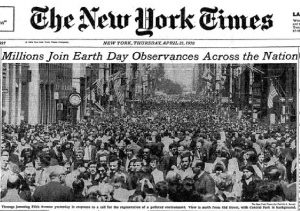Here we’re taking a look at some of the most ingenious and innovative ways to deal with the epidemic of plastic in our oceans.

April 22nd marks Earth Day —an annual event dedicated to tackling climate change, promoting sustainability, and protecting endangered species. Dating back to 1970, the first Earth Day took place across schools, colleges and universities in the US, but it quickly grew to encompass 192 countries around the world. Today, it is coordinated by the Earth Day Network, an organization created to broaden, educate, and activate both environmentalists and the general public. It is also the largest global movement dedicated to tackling our plastics problem.
As one of the most ubiquitous pollutants found in our oceans, plastic has recently taken center stage in the mainstream media and beyond. Recent reports have made the Great Pacific Garbage Patch the public face of plastic pollution. But the impact isn’t happening in isolation. In fact, the Ellen Macarthur Foundation estimates that there will be more plastic in oceans than fish by 2050. A frightening statistic that highlights the truly global scale of this crisis.
Of course, reducing and minimizing the use of plastics must be our priority, but that doesn’t solve the problem of how to deal with our existing waste. Today, we’ll take a look at some of the most innovative approaches to dealing with the plastic that is choking oceans around the globe.
The Ocean Cleanup
The brainchild of 18-year old Boyan Slat, The Ocean Cleanup project began in 2013 with a truly innovative idea for addressing the Great Pacific Garbage Patch. The concept was simple: create a cheap, automated system to collect the millions of tons of plastic waste that is continuously accumulating in the ocean gyre between Hawaii and California.
In order to sidestep costly and time-consuming plastic retrieval using conventional ships, Slat developed a 600-meter floating device with a 3-meter underwater skirt that was designed to collect waste from the surface. Ingenious yet simply constructed, the device moves along using wind, waves, and ocean currents while also allowing marine life to safely pass beneath it. Once plastic is gathered in the system’s naturally forming U-shape, it’s collected by a larger vessel and sent for recycling.
The first beta system was deployed in San Francisco Bay in 2018, but unfortunately it was beset by problems. However, Slat remains defiant in the face of failure, stressing that these initial challenges are an integral part of the development process. Optimism remains high around the project, and it is still hoped that numerous fully-functioning systems can be sent out into the Pacific over the next few years.
Sea Bin Project
Another idea that is sublime in its simplicity is the Sea Bin Project. Designed by Andrew Turton and Pete Ceglinski, the Seabin in is a trash skimmer designed to work in calmer environments such as marinas and ports. While it may not be made to tackle something as large as the Great Pacific Garbage Patch, it excels at collecting microplastics and microfibers, and it also does a decent job of absorbing petroleum-based oils and detergents.
How does it work?
The Seabin works by sucking water from the surface and filtering that water through a catch bag. It’s estimated that each device can collect a massive 90,000 shopping bags, 11,900 plastic bottles, 35,700 disposable cups, and 117,647 plastic utensils per year. Cigarette butts are the most commonly caught item but microplastics as small as 2mm in size can also be collected. A two-stage filter can also be added to the Seabin to collect microfibers.
Mr. Trash Wheel
Innovative in a way that doesn’t take itself too seriously, Mr. Trash Wheel™ is already credited with removing 1,119 tons of trash and debris from Jones Falls stream, Baltimore. That waste includes 11,228,900 cigarette butts, 1,000,000 foam containers, 852,449 plastic bottles, a guitar, and perhaps most fortuitously (at least for the snake) a ball python. Using a semi-autonomous system powered by either the river currents or solar panels, Mr. Trash Wheel funnels trash using a containment boom, and then rakes and conveys the trash into a dumpster on a separate barge. And, if Mr. Trash Wheel’s googly eyes aren’t enough to charm you, he has a growing family in Baltimore that now includes Professor Trash Wheel℠ (Harris Creek) and Captain Trash Wheel℠ (Masonville Cove).
Parley for The Oceans
Retrieving all that ocean plastic is one thing, but dealing with it when it’s back on terra firma is quite another. Parley for the Oceans does both. Through its network of clean-up organizations, Parley for the Oceans collects plastics and discarded fishing nets from shorelines and the high seas. The collected plastic is then sent for recycling into innovative new products, such as fabrics, clothing, and other apparel.
You might know Parley from its collaborations with Adidas, as well as a range of mainstream sneakers, swimwear, and other clothing manufacturers. The collaborations have earned much applause from fashionistas and environmentalists alike. Additionally, Parley for the Oceans is directly involved in the search for smarter plastic alternatives through its extensive research and development programs.

Get Your Hands Dirty
It might not be the most innovative approach, but what better way to celebrate Earth Day than by heading down to your local beach to get your hands dirty? It’s a tried and tested way to make an impact—however small. Earth Day organizers aim to achieve “a billion acts of green” in 2019, and they hope to raise that to three billion by the 50th anniversary observance in 2020. Activities involve thousands of beach cleanups around the world—so grab a discarded plastic shopping bag and start picking. You can treat yourself to a swim in a cleaner ocean after you’ve worked up a sweat!
Print this information for your fridge or bulletin board.
We’ll e-mail you a printable version.


